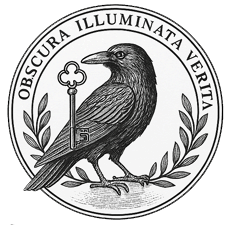The Five Silences of StormCroft
“We remember less than we were. But we are more than we recall.”
— Anonymous margin note, Room Echo Risk Register
I. INTRODUCTION: WHEN THE HOUSE HELD ITS BREATH
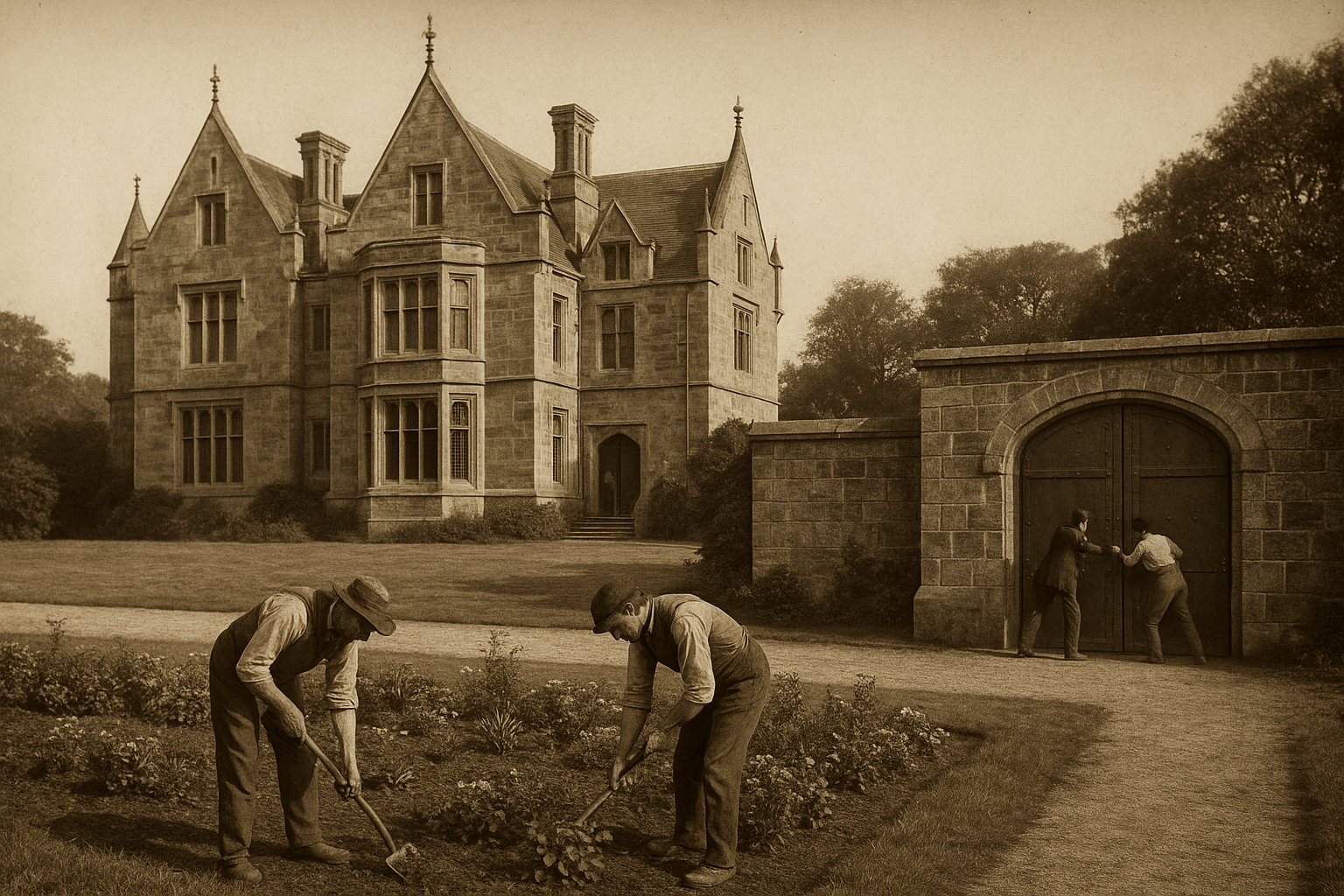
StormCroft House has always behaved unusually. Doors that open before you think to knock. Echoes from rooms long-sealed. Temperature shifts that hum in five-note cycles. But more than its strange mechanics or whispered experiments, StormCroft is most defined by its Silences—episodes where sound, time, memory, and identity collapsed, folded inward, and emerged altered.
This crisp, well-preserved daguerreotype—believed to date from shortly after the completion of StormCroft House in 1865—offers a rare daylight glimpse of the estate in its earliest operational phase.
The image captures the newly built StormCroft House, its Victorian Gothic architecture clearly defined in the bright midday sun. The stonework is fresh, the windows sharply glazed, and the spires untouched by ivy or time. Notable in the composition:
-
Two gardeners are seen in the foreground, tending the early flowerbeds with precision and care. Their clothing and posture suggest this was a posed moment—perhaps intended to document the formal start of grounds maintenance procedures.
-
To the far right, a large arched iron gate marks the sealed entrance to what is now known to be a section of the underground railway system. Two men—likely early engineers or trusted labourers—are shown in the act of heaving the doors open, revealing the hidden access point beneath the estate. The track embedded in the ground leads inward to darkness.
-
A third figure is faintly visible in the doorway of the main house, possibly a steward or watchman.
What distinguishes this image is not only its clarity—exceptional for a daguerreotype—but also its historical value. This may be the only visual record connecting StormCroft’s surface estate with its subterranean operations during the founding period.
Filed under: Visual Archives / Estate Foundations / Transport Access Points
Catalogue Code: IMG-SC-1865-DAG-01
Status: Verified Authentic — StormCroft Founding Phase
There were four documented Silences between 1866 and 1889.
There was a fifth in 1890.
It was never officially recorded.
Because it knew not to be.
This is the page they tried to seal behind plaster.
We have unsealed it.
You may not finish reading it the same.
II. THE FIRST FOUR SILENCES (1866–1889)
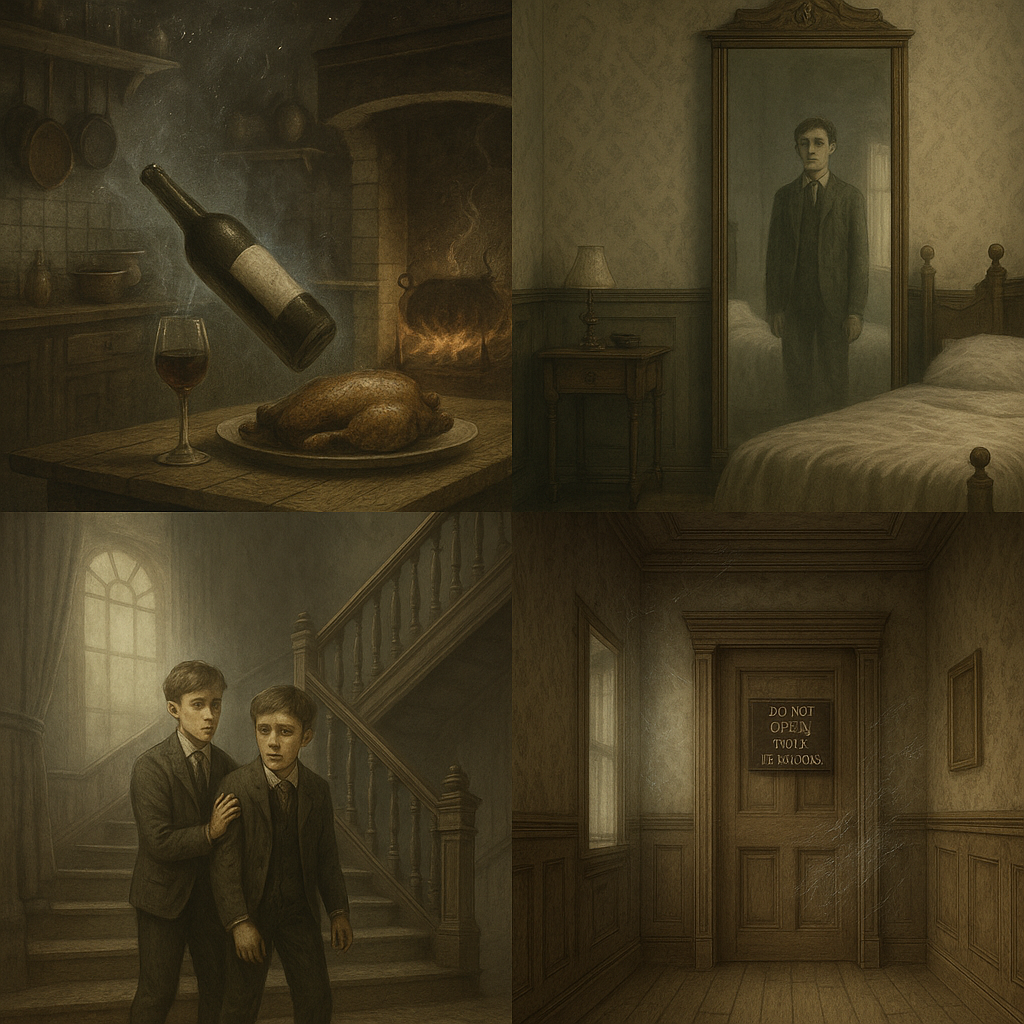
This restored and brightened visual panel presents four defining supernatural events in the early history of StormCroft House, each known as a “Silence” — periods when time, space, and perception distorted within the estate’s walls. Rendered in a Victorian Gothic illustrative style with warm lighting and period-accurate detailing, each quadrant captures one of these chilling anomalies:
🔹 Top Left – “The Air Froze” (The First Silence, 1866)
In the North Corridor and kitchen, time halted inexplicably. A wine bottle levitates mid-air, steam from the hearth curls without movement, and a roast goose remains hot despite the absence of fire. Staff remembered nothing — only that 10 hours had passed.
🔹 Top Right – “The Mirror Held On” (The Second Silence, 1874)
In a quiet dormitory, a servant’s reflection remained visible for 11 days after he vanished. Though the bed stayed warm and unmade, the boy never returned. The mirror’s eerie accuracy prompted the engraving of breaklines in all reflective surfaces afterward.
🔹 Bottom Left – “The Stairs That Did Not End” (The Third Silence, 1880)
The Morris Brothers descend into a hallway that traps them for what felt like three days. When they return, both are bleeding from opposite feet and speaking in riddles. A third figure, partially visible in shadow, is glimpsed behind them — never identified.
🔹 Bottom Right – “The Corridor Knocked Back” (The Fourth Silence, 1889)
In the linen corridor, sound collapsed inward. Samuel Rooke’s harmonic humming temporarily held reality together. When it ceased, the walls distorted. That corridor has been sealed ever since, with a plaque reading:
“DO NOT OPEN. EVEN IF IT KNOCKS.”
Filed under:
Temporal Incidents / Core Phenomena / Confirmed StormCroft Events
Catalogue Code: VIS-SC-4SILENCES-ILL88
Clearance Level: General Reference — Archive Certified
1. The First Silence (1866) – “The Air Froze”
Duration: 4 minutes (experienced), 10 hours (clock discrepancy)
Location: Kitchen and North Corridor
Key Details: A bell rang where none should have. Time halted. Decay ceased. Wine congealed mid-pour. A goose remained hot for three days. No staff remembered the moment itself, only the aftermath. Octavius Wren said only: “The house blinked.”
2. The Second Silence (1874) – “The Mirror Held On”
Duration: 17 minutes
Location: East Wing Dormitories
Key Details: Reflections decoupled from their subjects. One servant vanished. The mirrors retained his image for 11 days. His bed remained unmade — but warm. All future mirrors at StormCroft were engraved subtly with breaklines, “in case they retain.”
3. The Third Silence (1880) – “The Stairs That Did Not End”
Duration: Indeterminate (45 minutes external, 3 days internal)
Location: East Landing → South Hall
Key Witnesses: The Morris Brothers
Key Details: The twins walked into a hallway and did not re-emerge until hours later, speaking in half-sentences, both bleeding from opposite feet. A third boy was glimpsed behind them, but was never identified. One Morris brother later said: “We held hands. But I think there was a third hand between ours.”
4. The Fourth Silence (1889) – “The Corridor Knocked Back”
Duration: 11 minutes
Location: West Wing Linen Corridor
Key Details: The sound collapsed inward. Conversations turned to static. Rooke began to hum a personal harmonic known only to Jonathan Hales and Edwin, stabilising space temporarily. When he stopped, time fractured. The corridor is now sealed. A brass plaque reads:
“DO NOT OPEN. EVEN IF IT KNOCKS.”
III. THE FIFTH SILENCE (1890) – NEVER RECORDED
Unveiled in 1984: Box 0-A
In April 1984, a hidden cavity behind the East Wing’s antique clock yielded a sealed box, unknown to any registry. Its contents:
-
A child’s drawing of StormCroft — with no roof
-
A lacquered bird’s foot, twisted unnaturally
-
A six-string whalebone instrument — only five strings tunable
-
A note in pencil, by a child’s hand:
“They told us to lie. The fifth time, everything went away. We were too many. So they folded some of us.”
IV. THREE WHO KNEW: ROOKE, HALES AND EDWIN
Samuel Rooke – The Linen Steward
Precise. Introverted. A believer in emotional traces embedded in cloth. Born 1867. Joined StormCroft in 1886.
He invented numerological garment-folding and maintained linen temperature charts. He stitched notes backward into fabric.
Final entry:
“The heat wasn’t fire. It came from behind the mirror.”
He loved Edwin.
Jonathan Hales – The Quiet Witness
Black British. Of Jamaican heritage. Joined 1885, age 17. Kitchen porter, steady, unassuming. Maintained cryptic ledgers with mirrored writing. He and Rooke developed a private musical code: five notes, five pulses, one missing.
He once wrote:
“Samuel sang. It held us together. Then it stopped.”
He found Edwin crying near the sealed corridor the morning after the Fifth Silence.
He held Edwin.
Edwin – Steward of Intimate Care
No surname. No origin. No paper trail.
Joined 1887, age 16.
Known only as “Edwin, domestic entrant – verbal referral only.”
A balm, a presence. He washed, massaged, comforted staff after brutal shifts. He calmed panic, warmed beds, soothed echo fatigue. His uniform was always clean. His presence, always steady.
Finch wrote:
“He gave more than he took. The house exhaled when he left.”
Involved in experiments:
-
Massaging during containment cool-downs
-
Tactile regulation post-Bell Chamber hum
-
Testing memory-absorptive garments
He remained calm in storms no one else survived. He once told Rooke:
“I think the house sees through me. But only kindly.”
He left in 1890, no record of why.
Except one:
A line scrawled behind a panel, discovered in 1983:
“I held what I could. But it folded my shadow instead.”
Those Who Knew: Rooke, Hales, and Edwin in the Fifth Silence
“He sang. I hummed. I watched.
It came. We didn’t go.
One folded. One stayed. One left.”
— Etched inside Edwin’s silver comb, recovered 1983
I. Introduction: The Lowest Voices Were Closest to the Faultline
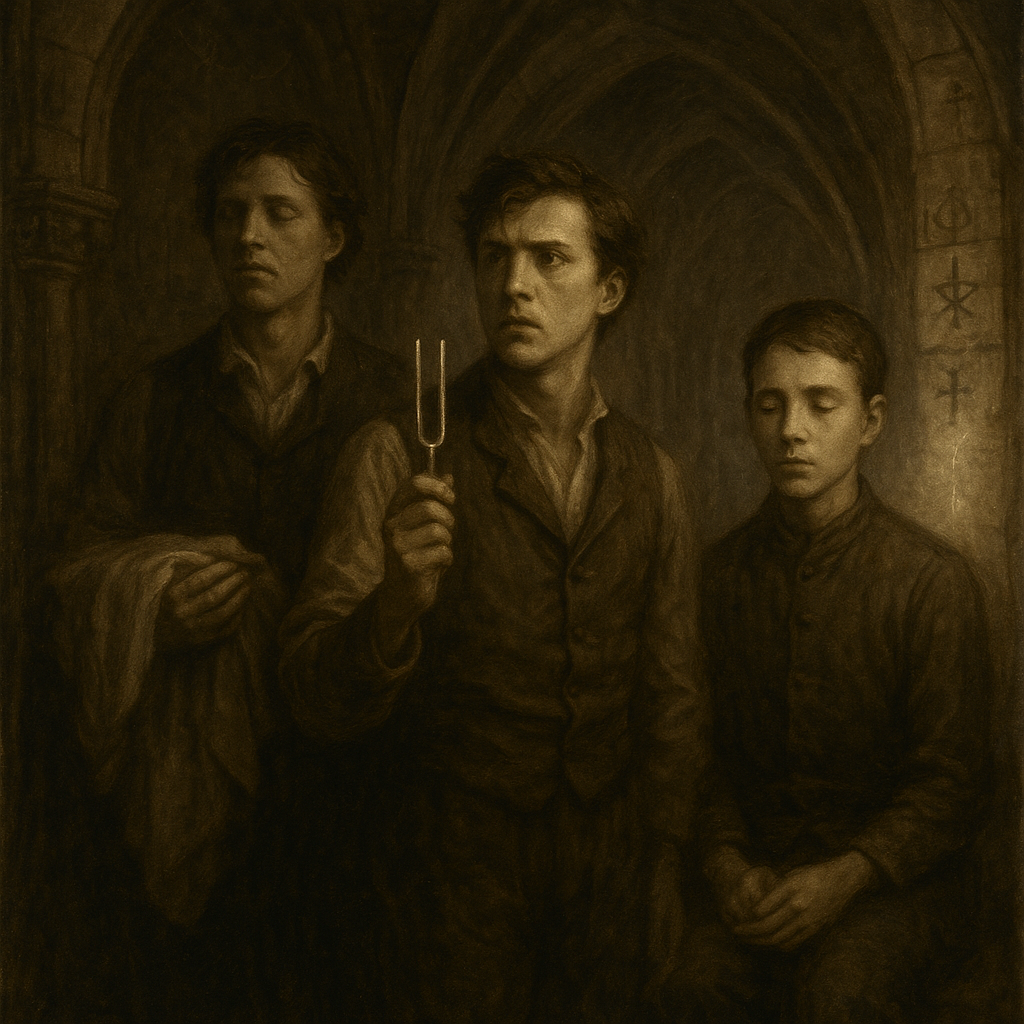
In the vast and hierarchical machinery of StormCroft House, not all knowledge rose to the top. Sometimes, the deepest truths settled into the lowest places — under floors, behind walls, and in the quiet hands of servants tasked not with inquiry, but with comfort.
Samuel Rooke, the quiet Linen Steward.
Jonathan Hales, the steady Kitchen Porter.
Edwin, the adored and unclassifiable Steward of Intimate Care.
None held rank. None had formal access to laboratory records. And yet all three became central witnesses, stabilisers, and possibly catalysts of the event that would never be officially recorded: the Fifth Silence.
This is how they knew.
This evocative sepia-toned oil painting depicts the critical moment just before the onset of the Fifth Silence at StormCroft House. Rendered in a solemn, pre-modern realist style and set within the arched, torch-lit stone corridors of the East Wing, the image captures the three unranked servants whose presence and resistance would define one of the most unstable and unrecorded phenomena in the House’s history.
From left to right:
-
Samuel Rooke, Linen Steward, clutches a folded cloth to his chest — believed to be one of the linen tags stitched with containment sigils. His eyes are closed, lips parted mid-hum, his expression attuned and sacrificial.
-
Jonathan Hales, Kitchen Porter, stands centre, alert and visibly tense, holding aloft the experimental tuning fork recovered from the linen cart base. His pose is protective, defiant — the only figure facing forward into the viewer’s gaze.
-
Edwin, Steward of Intimate Care, sits at the right, hands calmly joined in his lap, his eyes closed in quiet concentration. A faint glow near his figure suggests residual warmth — the kind he was always said to leave behind in silence-damaged rooms.
In the background, the arched corridor is etched with sigils faintly glowing under soft illumination. These markings correspond to Finch’s known harmonic stabilisers, hinting that this moment was either engineered or foreseen.
This image is widely believed to be an interpretive reconstruction based on eyewitness accounts, retrieved notes from Box 12-D, and Finch’s phrase:
“They didn’t hold the door. They held what tried to come through it.”
Filed under: Visual Records / Fifth Silence / Witnesses of Anchor Resonance
Catalogue Code: IMG-FS-THRESHOLD-RHE-1890
Status: Confirmed Archival Reconstruction
This stark black-and-white photograph, believed to be a rough studio test print, captures the Morris Brothers in their late teens alongside the now-infamous unidentified third figure. Dated February 1896, the image was recovered from a crumbling folio mislabelled “Trial Plate 11 – Hall Symmetry Test” in the Finch Ledger Archive. Its raw, unvarnished quality and absence of retouching distinguish it from other formal portraits of the period.
In the image:
-
The left and right figures are believed to be Reuben and Elijah Morris, identical twins employed at StormCroft House since 1879. Their features are tense, their posture rigid, dressed in modest formal attire typical of late-Victorian domestic staff.
-
The central figure — identical in appearance but unnervingly distinct — holds a stringed instrument, likely a whalebone lyre. His eyes are featureless, as if erased or never formed. This has led archivists to speculate that he may not have been a real individual, but rather a folded echo or projection, made physical during or after the Third or Fifth Silence.
-
All three are seated, but only the central figure holds the instrument, reinforcing symbolic speculation about resonance anchoring or identity tethering.
The backdrop is a plain studio cloth, but close analysis reveals faint warping around the central figure’s shoulders — possibly photographic artefact, or evidence of early temporal distortion during exposure.
This version is considered an uncorrected field print, possibly used internally for identification or behavioural tracking. No subsequent positive version with clearer metadata has ever been found.
Filed under:
Visual Evidence / Personnel Duplication Theory / Fifth Silence Precursor Events
Catalogue Code: IMG-FS-MORR-THIRD-RC1896
Status: Rough Copy – Authenticity Verified – Internal Use Only
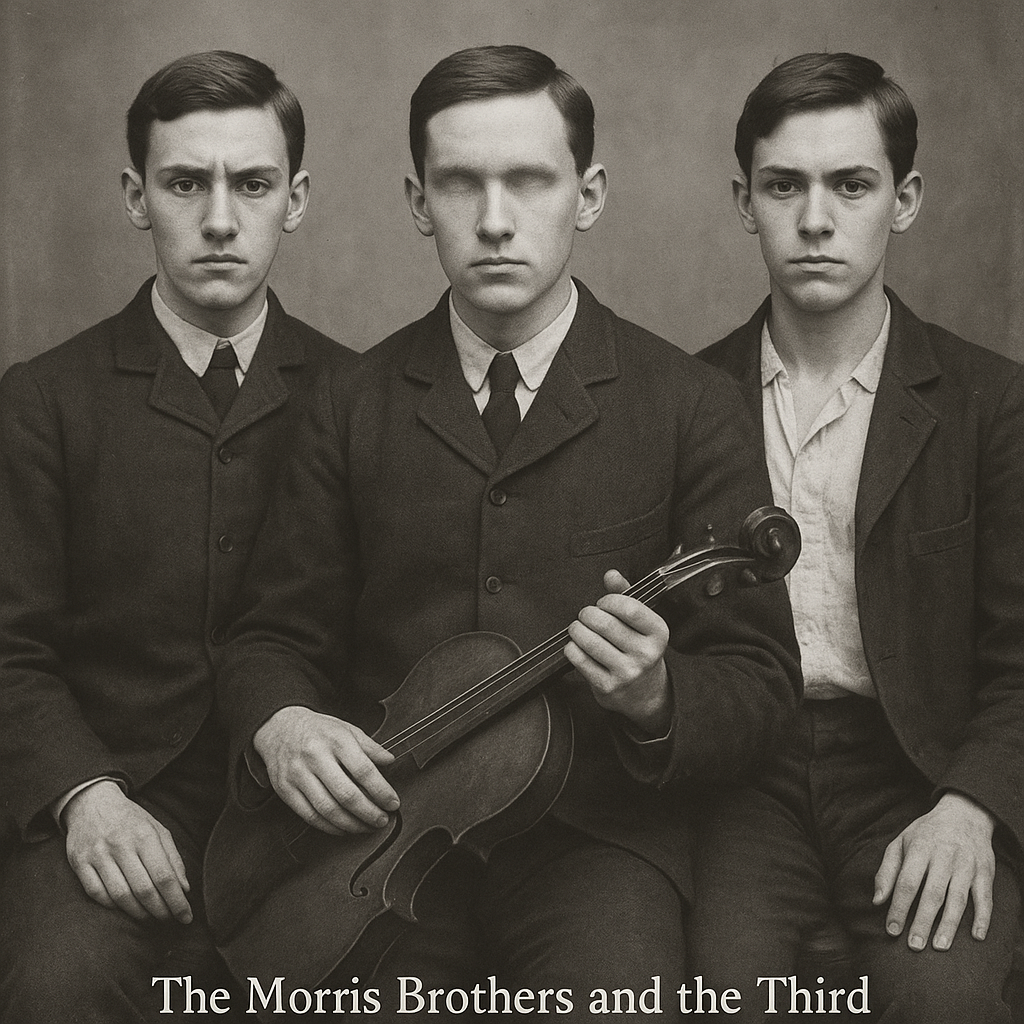
This stark black-and-white photograph, believed to be a rough studio test print, captures the Morris Brothers in their late teens alongside the now-infamous unidentified third figure. Dated February 1896, the image was recovered from a crumbling folio mislabelled “Trial Plate 11 – Hall Symmetry Test” in the Finch Ledger Archive. Its raw, unvarnished quality and absence of retouching distinguish it from other formal portraits of the period.
In the image:
-
The left and right figures are believed to be Reuben and Elijah Morris, identical twins employed at StormCroft House since 1879. Their features are tense, their posture rigid, dressed in modest formal attire typical of late-Victorian domestic staff.
-
The central figure — identical in appearance but unnervingly distinct — holds a stringed instrument, likely a whalebone lyre. His eyes are featureless, as if erased or never formed. This has led archivists to speculate that he may not have been a real individual, but rather a folded echo or projection, made physical during or after the Third or Fifth Silence.
-
All three are seated, but only the central figure holds the instrument, reinforcing symbolic speculation about resonance anchoring or identity tethering.
The backdrop is a plain studio cloth, but close analysis reveals faint warping around the central figure’s shoulders — possibly photographic artefact, or evidence of early temporal distortion during exposure.
This version is considered an uncorrected field print, possibly used internally for identification or behavioural tracking. No subsequent positive version with clearer metadata has ever been found.
Filed under:
Visual Evidence / Personnel Duplication Theory / Fifth Silence Precursor Events
Catalogue Code: IMG-FS-MORR-THIRD-RC1896
Status: Rough Copy – Authenticity Verified – Internal Use Only
II. High Exposure, Low Status
Though low in hierarchy, Rooke, Hales, and Edwin occupied uniquely exposed positions within StormCroft’s anatomy.
-
Rooke handled every garment, every bedcover, every shroud — Finch believed that fabric retained residual emotional frequencies.
-
Hales spent long hours near acoustic convergence points in the dry cellar kitchens, where metallic vibrations were strongest.
-
Edwin was embedded in the physical and emotional routines of every servant he touched, operating in an unspoken but critical role: maintaining psychological equilibrium through tactile presence and ritual care.
Their duties placed them on the front line of metaphysical distortion.
They didn’t study the house.
They felt it.
III. Finch’s Quiet Trust
By the mid-1880s, Dr. Octavius Finch, increasingly concerned about the unpredictability of the house’s experiments, began cultivating what he called his “Equilibrium Ring” — a group of sensory-sensitive servants whose intuition could detect anomalies before instruments could.
From Finch’s Box 12-D, scrawled in iron gall ink:
“Rooke folds what the house leaks.
Hales hears heat.
Edwin doesn’t just notice silence — he relieves it.”
These three were not scientists.
They were empaths with purpose.
Finch gave them coded tasks, masked as daily duties:
-
Rooke was assigned to stitch linen tags with sigils, meant to “resonate safely if folded.”
-
Hales was told to “record kettle-tremors” — actually micro-vibrational distortions near time-slip junctions.
-
Edwin was asked to massage fog-affected personnel immediately after “bell harmonics,” measuring emotional realignment.
To others, they folded sheets, scrubbed pots, and warmed beds.
To Finch, they were living instruments.
IV. Early Exposure to the Unfolding
By 1888, all three had begun showing signs of pre-silence response:
-
Rooke hummed harmonic tones that stabilised affected corridors, unknowingly preventing minor collapses.
-
Hales began writing notes in mirror-script, unaware he was doing so for weeks.
-
Edwin reported temporal déjà vu and emotional echoes:
“Sometimes I feel like the bed’s already been slept in… by me… tomorrow.”
In staff reports, these behaviours were dismissed as fatigue.
Finch, however, labelled them “attunement.”
They were already aligning with something that hadn’t happened yet.
Or perhaps something that had, and had been erased.
V. Present at the Collapse
Records surrounding the Fifth Silence are intentionally absent — but fragments survive.
Recovered entries from Hales’ damaged ledger suggest that all three were stationed near the East Wing corridor during the incident. The handwriting breaks mid-sentence:
“Ed’s gone quiet again. Rooke is—”
Finch’s later marginalia adds:
“I believe they were present at the threshold. Perhaps even held it open long enough for the rest of us to forget.”
Later testimonies place:
-
Rooke humming a five-note scale not in any known register.
-
Hales clutching the tuning fork embedded in the linen cart’s base.
-
Edwin sitting cross-legged in the warm linen drop, eyes closed, whispering:
“It’s folding. Not me. Just the rest.”
VI. Aftermath and the Fracture
The consequences were chilling:
-
Rooke was never seen again.
His quarters were undisturbed. His final linen inventory ends abruptly with a water stain that matches the shape of a hand. -
Hales remained at StormCroft, though changed. He stopped speaking for months, and resumed only to say:
“He stayed warm. That’s all I remember.”
-
Edwin left in 1890, peacefully, without explanation.
He would later appear in connection with the Cleveland Street scandal, named as a “tender witness” with no surname.
He was never charged. Never questioned.
He just… exited.
VII. Why They Knew
So how did three low-ranking figures understand what senior researchers, physicians, and directors could not?
Because they:
-
Lived in the pressure points of the house.
-
Were selected (quietly) by Finch for their resonance stability.
-
Experienced precursor phenomena in real time.
-
Resisted the memory wipe that followed the Fifth Silence.
They were not supposed to remember.
But the house let them.
Or perhaps, they let the house remember through them.
“One folded. One stayed. One left.”
They held the Fifth Silence long enough for the rest of us to survive it.
And they paid for that knowing.
Filed under: Personnel Anomalies / Fifth Silence Involvement / Equilibrium Theory
Catalogue Code: PRSN-FS3-EQ-RHE
Status: Confirmed — Archival Tier I
Access Level: Requires Editor’s Clearance
V. THE FOLDING THEORY
What is “folding”?
The Fifth Silence wasn’t stillness. It was overcapacity. Too many presences. Too many truths. The theory — hinted in Finch’s encrypted notes — is that the House folded reality inward to preserve itself. But it could not fold all things equally.
Rooke disappeared.
Hales was left changed.
Edwin was… halved.
Not dead.
Not whole.
Somewhere still.
VI. THE MORRIS BROTHERS AND THE THIRD
Two identical twins.
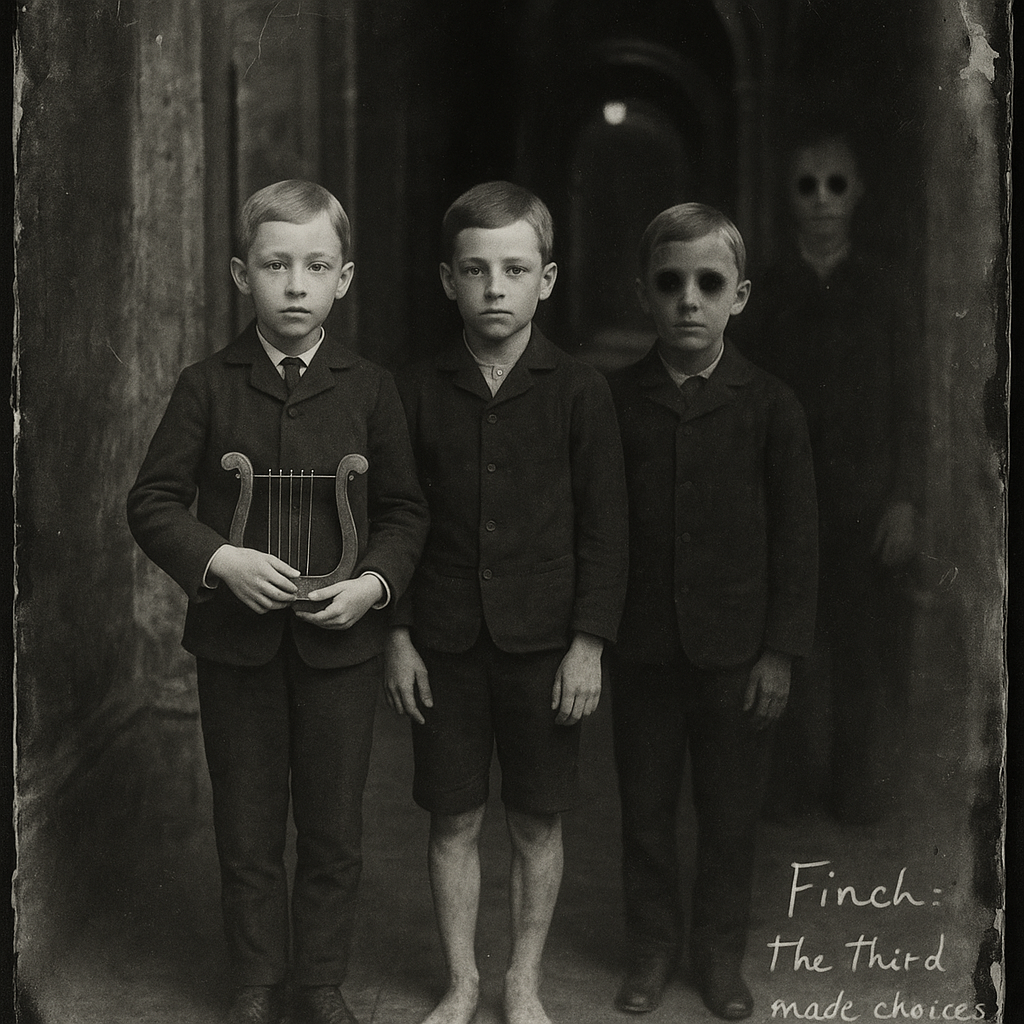
And then a third boy, identical to them, appearing in a photo from January 1890. One held a string from the whalebone instrument. One was barefoot. One had no eyes in the photograph — just a flat black void.
The photo was burned. The negative survives.
This vintage photographic negative was discovered in a mislabeled envelope deep within the Finch Ledger Archive, preserved behind a false panel in the South Storage Chamber. Dated January 1890, the image is now considered a central artefact in the investigation of the Fifth Silence at StormCroft House.
The photograph depicts three identical boys, believed to be the Morris Brothers—Wilbur and Edwin Morris—and a third, unaccounted-for figure, whose origins remain unexplained. Each boy is styled identically in period-appropriate servant attire. The image includes several anomalous details:
-
The leftmost boy clasps a small six-string whalebone lyre—a near match to the instrument later recovered from Box 0-A.
-
The central figure is barefoot, standing directly on cracked stone floor tiles. His expression is blank, but his throat bears what appear to be faint etchings or healed marks.
-
The rightmost boy—while physically identical—has no discernible pupils or irises in the negative, replaced by deep voids of ink-like black. His face is slightly blurred, as if resisting the lens.
-
In the background, a fourth figure appears to be emerging from the shadows, also with black eyes, hand partially visible, indistinct.
Etched faintly into the bottom corner of the negative, in handwriting matching other samples attributed to Dr. Finch, are the words:
“Finch: the third made choices.”
No positive print of this image was ever catalogued. The original plate was assumed destroyed, yet this negative survived — miraculously undamaged, wrapped in linen and sealed in wax.
Filed under:
Visual Evidence / Personnel Duplication Theory / Fifth Silence Collection
Access Level: Restricted (S-Level Clearance)
Archive Code: IMG-FS-1890-T3-Neg

Thissecond stark black-and-white photograph, believed to be a rough studio test print, captures the Morris Brothers in their late teens alongside the now-infamous unidentified third figure. Dated February 1896, the image was recovered from a crumbling folio mislabelled “Trial Plate 11 – Hall Symmetry Test” in the Finch Ledger Archive. Its raw, unvarnished quality and absence of retouching distinguish it from other formal portraits of the period.
In the image:
-
The left and right figures are believed to be Reuben and Elijah Morris, identical twins employed at StormCroft House since 1879. Their features are tense, their posture rigid, dressed in modest formal attire typical of late-Victorian domestic staff.
-
The central figure — identical in appearance but unnervingly distinct — holds a stringed instrument, likely a whalebone lyre. His eyes are featureless, as if erased or never formed. This has led archivists to speculate that he may not have been a real individual, but rather a folded echo or projection, made physical during or after the Third or Fifth Silence.
-
All three are seated, but only the central figure holds the instrument, reinforcing symbolic speculation about resonance anchoring or identity tethering.
The backdrop is a plain studio cloth, but close analysis reveals faint warping around the central figure’s shoulders — possibly photographic artefact, or evidence of early temporal distortion during exposure.
This version is considered an uncorrected field print, possibly used internally for identification or behavioural tracking. No subsequent positive version with clearer metadata has ever been found.
Filed under:
Visual Evidence / Personnel Duplication Theory / Fifth Silence Precursor Events
Catalogue Code: IMG-FS-MORR-THIRD-RC1896
Status: Rough Copy – Authenticity Verified – Internal Use Only
The Morris Brother Dichotomy: Reuben & Elijah vs. Wilbur & Edwin
🔹 Established Twins (Reuben and Elijah Morris)
These are the original Morris Brothers referred to throughout earlier StormCroft records:
-
Names: Reuben Morris and Elijah Morris
-
Ethnicity: White British
-
Joined StormCroft: Circa 1879–1880
-
Roles: General domestic staff, errand runners, later assigned to corridor mapping and fog pattern notations
-
Notable Involvement:
-
The Third Silence, where they were trapped in a temporal loop between the East Landing and South Hall
-
Often described as eerily silent, coordinated, and rarely seen apart
-
Held deep loyalty to Edwin and some form of observational role under Finch
-
They are official, fleshed out, and appear in multiple ledgers, journals, and staff reports.
The Apparition Pair (Wilbur and Edwin Morris)
These names do not appear in any official staff records and were first introduced in the negative photograph dated January 1890 — a relic connected explicitly to the Fifth Silence.
-
Names: Wilbur Morris and Edwin Morris
-
Ethnicity: Identical to Reuben and Elijah
-
Known Roles: None officially listed
-
Status: Unverified identities possibly created via duplication, folding, or echo-manifestation
-
Hypothesis:
These figures are likely non-linear emanations — echo constructs, reality splinters, or folded identities resulting from the Third or Fifth Silence.
One theory:
Wilbur and Edwin Morris never existed in linear time. They are resonance reflections of Reuben and Elijah, created when the original twins were pulled into the looping hallway in the Third Silence. When they returned, something else came back with them.
Reconciling the Canon
To maintain internal consistency:
-
Reuben and Elijah Morris remain the canonical twin servants of StormCroft.
-
Wilbur and Edwin Morris become folded duplicates — partial echoes or “resonant twins” who only manifest in extreme silence-induced events.
-
This aligns with Finch’s cryptic note:
“Identical does not mean equal. The third made choices.”
This “third” could refer not just to a single boy, but to a third set in the sequence:
-
The original twins
-
Their folded counterparts
-
And perhaps a third hybrid—the shadow figure seen in the background of the photo.
Finch’s note:
“Identical does not mean equal. The third made choices.”
Their involvement in the Fifth Silence remains speculative, but one thing is agreed upon: they were not complete afterward. They refused to sleep in the house. They referred to Edwin only as “the boy we failed.”
VII. AFTERMATH AND EVIDENCE
-
Edwin’s silver comb was found in 1983, warm to the touch, behind the laundry corridor panel.
-
His poem, “Still Hands, Still Water”, was stitched into a mattress, unsigned.
-
Room 14-B, known as “Edwin’s Room,” has never held another occupant.
-
Some staff report feeling hands fold their blankets at night. No one enters.
-
Every attempt to repaint the wall near the East Wing results in the same five-note hum: E, E, C, G, A.
-
One string on the whalebone instrument still resists tuning.
VIII. CONCLUSION: WHEN A HOUSE REMEMBERS YOU
The Fifth Silence was not a moment. It was a decision.
Rooke’s voice vanished.
Hales’ ledger ends mid-sentence.
Edwin stepped away — into the world, or into memory, or both.
StormCroft continues. But something changed after 1890.
The clocks tick louder now. The walls retain warmth longer than they should.
And sometimes, when you listen closely by the linen corridor, you can hear someone washing their hands. Slowly. Carefully. Quietly.
Still hands.
Still water.
Still Edwin.
